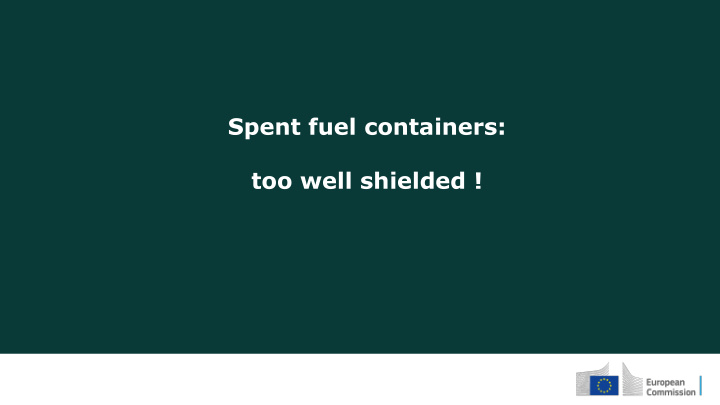



Spent fuel containers: too well shielded !
The European Commission’s science and knowledge service Joint Research Centre Isabella Maschio Nuclear Security unit - Ispra (Italy)
Spent nuclear fuel World EU States with 70 14 (21) nuclear programmes t HM 370 000 162 300 spent fuel t HM 120 000 104 000 spent fuel in reprocessing t HM 250 000 58 000 spent fuel in storage
Safety requirement for spent fuel containers • Criticality control : prevent criticality moderator exclusion, n absorbing materials, n flux traps • Radiological safety : prevent release of radioactive material, direct radiation from surface, surface contamination shielding • Structural and thermal design: to maintain criticality and radiological safety also under structural and thermal (internal and external) stresses Canister + overpack Cask
Safeguards approach for spent fuel management facilities It can be cost effective to perform any desired measurements on an item before placing it into difficult to access storage Once an item has been measured by the operator and verified by the IAEA, more rigorous surveillance, containment and monitoring measures can be applied to reduce the need for re-measurement IAEA, International Safeguards in the Design of Facilities for Long Term Spent Fuel Management, NF-T-3.1, 2018
Safeguards measures for spent fuel management facilities Verification of Nuclear Material • Identification and localisation of fuel elements: no missing, no dummies = partial defect verification • Characterisation of the fuel: Burn up Initial enrichment Cooling time Continuity of Knowledge • Containment: seals • Surveillance: surveillance camera, laser based systems • Monitoring: radiation monitoring
Instruments approved by IAEA for verification • attended verification : Cerenkov Viewing Device • partial defect verification • verifies that fuel has been irradiated, can distinguish non fuel • only in wet storage • needs access from above for each assembly • unattended method : Fork DETector (FDET) gamma and neutron measurement • total n count and gross gamma intensity • assess burnup (more quantitative verification of U and Pu content) • but assemblies must be moved to the detector • unattended: can provide near real time measurement
ONKALO (FI) 2024 http://www.posiva.fi/en/final_disposal/ Forsmark (SW) 2030 https:// www.skb.com / CIGEO (FR) 2025 https://international.andra.fr/
Proposed solution for the verification of spent fuel at the ONKALO encapsulation plant Integrated NDA system based on 2 complementary techniques: PGET – Passive Gamma Emission Tomography – can perform pin level detection but cannot measure neutron multiplication in assembly PNAR – Passive Neutron Albedo Reactivity instrument that complements PGET: can measure neutron multiplication in assembly but cannot perform pin level detection V. Litichevskyi et al , Helsinki Institute of Physics, Spent Fuel Assembly Characterisation by a Passive Neutron Albedo Reactivity Instrument as a part of Integrated NDA System for Encapsulation Safeguards, at ESARDA Annual Meeting (Luxembourg, 2018)
• Loss of Continuity of Knowledge (e.g. broken seal) • Loss of integrity of the container (leakage) • Failure of surveillance system re-verification of a sealed container with heavy shielding, bulk material • Needs highly penetrating probes • Requires low absorption of probe and emitted signal Possible techniques: muon or antineutrino
Future R&D for spent fuel verification and re-verification • Hybrid integrated systems based on complementary NDA techniques for the verification of spent fuel • Exotic techniques for the re-verification of spent fuel • Imaging techniques (e.g. tomography): best use of information for partial defect localisation • Modelling and simulation : increase reliability of nuclear material characterisation for confrontation with measured results • Strengthening containment , surveillance and monitoring • Better use of data from operator’s process monitoring and control, data analytics, secure data management
Ongoing research at JRC Nuclear material verification, NDA • Pulsed n interrogation facility • Gamma Spectroscopy and Delayed Gamma Spectroscopy • Muon tomography (exploratory research) Containment, surveillance and monitoring • Ultrasonic seal, ultrasound identification and authentication of welding in copper canisters • Laser based systems for Containment and Surveillance • Integrated nuclear process monitoring
Acknowledgments Stefan Nonneman, Kamel Abbas, Francesco Raiola – Nuclear Security unit References • IAEA, Status and trends in spent fuel and radioactive waste management , 2018 • IAEA, International safeguards in the design of facilities for long term spent fuel management , 2018 • International Conference on the Management of Spent Fuel from Nuclear Power Reactors: Learning from the Past, Enabling the Future , 24-28 June 2019, IAEA – Vienna (Austria) • ESARDA Symposium, May 2019, Stresa (Italy) • ESARDA Bulletin n. 56, June 2018 Contact isabella.maschio@ec.europa.eu
Recommend
More recommend